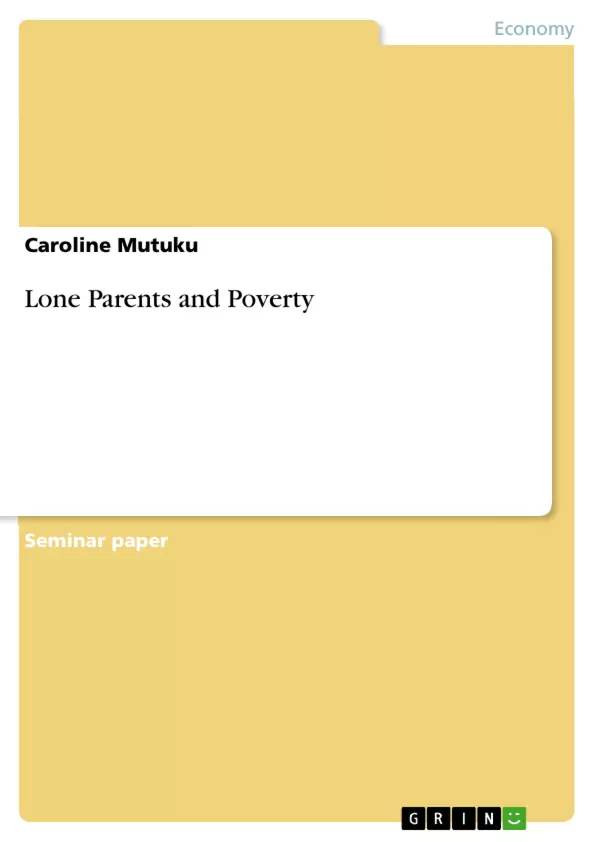Over decades, it is evident that family structures have experienced a remarkable change, and they are still undergoing transient evolution. This phenomenon has been witnessed across Europe, as well as other parts of the world. However, it is worth noting that the massive changes in family structural characteristics have occurred at different timings, albeit with different reasons (European Commission, 2007). Of great consideration is lone parenthood which has been associated with a high risk of poverty. Lone parents are most likely to become poor due to various reasons. Evidence shows that the phenomenon of lone parenthood contributes to social exclusion in the society due to poverty. Rowlingson & Mckay (2014) remark that “lone parent families are poor families” (p. 32). This is one of the consequences of classism ideology. As a result, social exclusion has led to the failure of families to accomplish their core functions including child care and mentorship. In Europe, survey statistics show that 16.6 percent of lone parents are living in abject poverty compared to only 5.5 percent of the total European population. In total, there are 1.8 million lone parent families in the United Kingdom and 52 percent comprises of single mothers (European Commission, 2007). This implies that poverty among lone parent households is emerging as serious social and economic issue. European Commission (2007) observes that lone parent households are experiencing poverty and social exclusion, a situation if not addressed, may cause immense consequences including the transmission of poverty to upcoming generations within lone parent households. This implies that these poor children may grow to become socially excluded adults; thus increasing inequality in the society. Therefore, this research paper will provide a critical overview on lone parenthood and poverty.
Inhaltsverzeichnis (Table of Contents)
- Introduction
- Causes of Lone Parenthood
- Single Motherhood
- Cohabitation and Divorce
- Factors Contributing to Poverty
- Low Educational Attainment
- Labour Market Participation
- Barriers for Getting Out of Poverty
- Poverty Trap
- Access to Affordable Childcare
- Overcoming Poverty Consequences
Zielsetzung und Themenschwerpunkte (Objectives and Key Themes)
This research paper aims to provide a critical overview of the relationship between lone parenthood and poverty. It explores the causes of lone parenthood, the factors that contribute to poverty among lone parent households, and the barriers that hinder their transition out of poverty.
- The growing phenomenon of lone parenthood in Europe and its connection to poverty.
- The social and economic factors that contribute to the high risk of poverty among lone parents, including low educational attainment and limited labor market participation.
- The challenges faced by lone parents in overcoming poverty, such as the poverty trap and access to affordable childcare.
- The social exclusion and consequences associated with poverty among lone parent families, highlighting the potential intergenerational transmission of poverty.
- Potential strategies for overcoming poverty and achieving greater economic and social inclusion for lone parent families.
Zusammenfassung der Kapitel (Chapter Summaries)
The introduction establishes the significant rise in lone parenthood across Europe and its association with a high risk of poverty. It highlights the social exclusion experienced by lone parent families due to poverty, with statistics demonstrating the prevalence of this issue. The paper outlines the research focus, which is to critically examine the connection between lone parenthood and poverty.
The chapter on causes of lone parenthood examines the factors contributing to the prevalence of single mothers. It explores how female reproductive age, cohabitation trends, and the rising divorce rates contribute to the increase in lone parenthood. The role of social class and poverty in divorce rates is also analyzed, highlighting the cyclical nature of poverty.
The section on factors contributing to poverty delves into the economic challenges faced by lone parent households. It examines how low educational attainment and limited labor market participation contribute to their increased risk of poverty. The chapter highlights the disparities in educational levels between lone and married mothers, and the challenges of balancing employment with childcare responsibilities.
The chapter on barriers to escaping poverty focuses on the obstacles lone parents face in transitioning from welfare to work. The "poverty trap" is discussed, where financial assistance is lost upon entering employment. The difficulty in accessing affordable childcare for lone parents is also highlighted, limiting their ability to pursue educational and training opportunities.
Schlüsselwörter (Keywords)
This research paper explores the complex interplay of lone parenthood, poverty, social exclusion, educational attainment, labor market participation, childcare access, and the poverty trap. It examines the social and economic factors that contribute to the high risk of poverty among lone parent families, emphasizing the need for effective interventions to address this persistent societal issue.
- Arbeit zitieren
- Caroline Mutuku (Autor:in), 2018, Lone Parents and Poverty, München, GRIN Verlag, https://www.grin.com/document/432502



